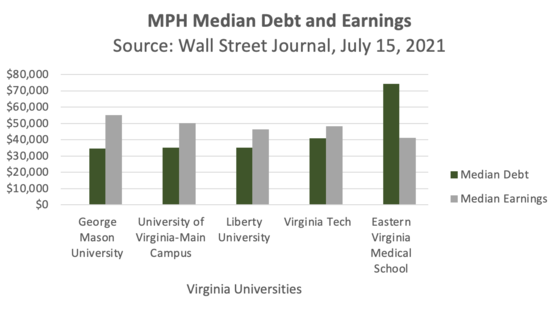Topics
When compared to nearby programs, graduates of Mason’s MPH program boast one of the best debt-to-income ratios two years post-graduation and the best in the state.
Amid reports that many advanced degree programs in the United States leave graduates in financial debt for years after graduation, the Wall Street Journal published an online tool comparing the debt-to-income ratio of graduates from different programs and different universities across the country.
When using this metric, George Mason University’s College of Health and Human Services’ (CHHS) Master of Public Health (MPH) degree fared the best compared with other MPH programs in Virginia. When compared with nearby programs in the region, the College’s program again boasted among the best debt-to-income ratios.
“As we have known for some time, a Mason degree offers great value to its students. We pride ourselves in offering a world-class education right here in Virginia,” says Dean of the College Germaine Louis. “Our graduates often stay in the region to pursue public health careers, creating further value for the region.”
“The College is just miles away from the hub of public health policy, research, and practice, which presents countless internship and job opportunities, and Mason offers a public health program that produces graduates with the lowest debt in the state,” Louis says.
Most favorable debt-to-income ratio in the state
The online tool published by the Wall Street Journal compares students’ earnings two years after graduation relative to their debt load. They looked at most universities at different program levels, including bachelor’s, master’s, doctorate, and professional degree programs. The data are based on students’ median earnings two years after graduation at every one of the 123 schools that offer a master’s in public health in the United States, according to Education Department data on federal loan borrowers.
A ratio above one means a typical student would have more debt than income two years after graduation. A ratio below one means the typical graduate has greater income than debt two years after graduation.

When compared against the other Master of Public Health programs in the state, Mason graduates had the lowest median debt at $34,709, the highest median income at $55,061, and also the best debt-to-income (0.63) ratio. Comparable numbers for Virginia Tech MPH graduates were $41,000, $48,265, and 0.85, and for University of Virginia MPH graduates, the numbers were $35,213, $50,231, and 0.7, respectively.
“The College is dedicated to educating the next generation of public health leaders—one that reflects the diversity of the communities we serve—and we’re proud that we can help do so with a high return on investment,” says Louis.
Public health graduates in high demand
News of Mason’s attractive debt-to-income ratio comes at a highly visible time for public health. With the COVID-19 pandemic at the forefront of the world’s stage, many people are turning to public health programs for careers and to find ways to help and give back.
“The COVID-19 pandemic has highlighted the critical and immense need for public health, and the multifaceted behavioral, economic, health, and societal ramifications of an inadequate public health infrastructure,” says Louis.
